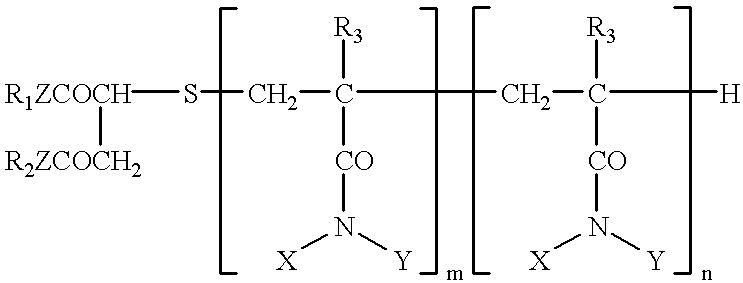Ink jet printing method
a printing method and jet technology, applied in the direction of inks, instruments, measurement apparatus components, etc., can solve problems such as unacceptable image quality defects
- Summary
- Abstract
- Description
- Claims
- Application Information
AI Technical Summary
Benefits of technology
Problems solved by technology
Method used
Image
Examples
example 1
Synthesis of P-1
Acrylamide (35.50 g, 0.50 moles) and 1-dodecanethiol (10.10 g, 0.050 moles) were suspended in ethanol (250 ml) under nitrogen atmosphere in a 1L three necked round bottomed flask equipped with a reflux condenser. The solution was stirred and degassed with nitrogen for 20 minutes. Stirring was continued and the temperature raised to 70.degree. C. over a period of 20 minutes during which time the reagents dissolved. 2,2'-Azo-bis(2-methylpropionitrile)[AIBN] (1.00 g, 6.10 mmoles) was added to the stirred solution at 70.degree. C. and heating continued for 4 hours under the control of an automated reactor system. During this time a white suspension formed. After cooling, the resulting white precipitate was filtered under suction and dried in vacuo to give a white powder (39.6 g, 87%). Analysis of this product was consistent with the desired product P1.
The preparation of other oligomeric species was performed using a similar procedure. Where no precipitate formed the alco...
example 2
Synthesis of Polymer P8
Mercaptoacetic acid (92.10 g, 1.00 moles) and oleyl alcohol (268.5 g, 1.00 moles) were suspended in toluene (1200 ml) in a 2L RB flask. Toluene sulfonic acid hydrate (2.0 g) was added as catalyst and the flask set up for reflux with a Dean & Stark trap. The components went into solution as the mixture was warmed and the whole was refluxed under argon atmosphere for 6 hours during which time approximately 18.5 ml of water collected in the side arm The reaction mixture was concentrated by evaporation under reduced pressure then redissolved in ethyl acetate (1.2L) and washed with saturated aqueous sodium hydrogen carbonate (600 ml). The organic layer was separated, dried over anhydrous magnesium sulfate, filtered and evaporated to give a pale yellow oil (Yield=344.0 g, 100%). Analytical data was consistent with oleyl mercaptoacetate.
Oleyl mercaptoacetate (12.99 g, 0.038 moles), sodium 2-acrylamido-2-methyl-1-propane sulfonate (34.77 g, 0.152 moles) and AIBN (0.13...
example 3
Synthesis of Polymer P5
Mercaptosuccinic acid (15.10 g, 0.10 moles) and 2-ethyl-1-hexanol (26.30 g, 0.20 moles) were suspended in toluene (200 ml) in a 500 ml round bottomed flask. Toluene sulfonic acid hydrate (0.10 g) was added as catalyst and the flask set up for reflux with a Dean & Stark trap. The components went into solution as the mixture was warmed and the whole was refluxed under argon atmosphere for 18 hours. The reaction mixture was concentrated by evaporation under reduced pressure then redissolved in ethyl acetate (500 ml) and washed sequentially with saturated aqueous sodium hydrogen carbonate (300 ml) and water (300 ml). The organic layer was separated, dried over anhydrous magnesium sulfate, filtered and evaporated to give a pale yellow oil (31.1 g, 83%). Analysis was consistent with di-(2-ethyl-1-hexyl)mercaptosuccinate.
Di-(2-ethyl-1-hexyl)mercaptosuccinate (24.60 g, 0.066 moles) and N,N-dimethylacrylamide (97.65 g, 0.985 moles) were dissolved in methanol (260 ml) i...
PUM
| Property | Measurement | Unit |
|---|---|---|
| particle size | aaaaa | aaaaa |
| viscosity | aaaaa | aaaaa |
| viscosity | aaaaa | aaaaa |
Abstract
Description
Claims
Application Information
 Login to View More
Login to View More - R&D
- Intellectual Property
- Life Sciences
- Materials
- Tech Scout
- Unparalleled Data Quality
- Higher Quality Content
- 60% Fewer Hallucinations
Browse by: Latest US Patents, China's latest patents, Technical Efficacy Thesaurus, Application Domain, Technology Topic, Popular Technical Reports.
© 2025 PatSnap. All rights reserved.Legal|Privacy policy|Modern Slavery Act Transparency Statement|Sitemap|About US| Contact US: help@patsnap.com



